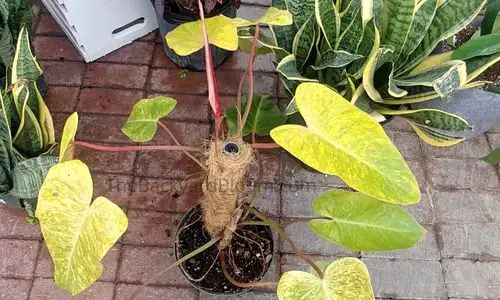The Philodendron Painted Lady is not a rare plant, but it is also not a common Philodendron to find in plant shops. It is a beautiful climbing Philodendron that can be surprisingly easy to care for despite its delicate look. They are known for their unique yellow leaves with specs of green throughout and red petioles. This color combo gives quite the eye-catching look for a houseplant. If you are thinking about buying a Philodendron Pink Lady or have already gotten one then this care guide can give you all you need to know about Philodendron Painted Lady Care.
Philodendron Painted Lady Origin
The Philodendron Painted Lady is a hybrid Philodendron erubescens that comes from the Philodendron Burgundy and the Philodendron Emerald Queen.
The Philodendron erubescens has been often hybridized due to many programs in Florida to find new cultivars to introduce to the market. Other hybrids from these sorts of programs include the Philodendron Prince of Orange and Philodendron Imperial Green. The Painted Lady Philodendron is also a result of one of these programs. There was a patent filed in 1976 by Robert H. McColley for the Philodendron Painted Lady, USPP3958P.
Philodendron Painted Lady Scientific Name:
- Philodendron erubescens ‘Painted Lady’

Quick Overview of How to Care for a Philodendron Painted Lady
- Water once the soil has dried out.
- Light: Bright indirect light is best, but can live in lower light.
- Temperatures: 65° F – 80° F
- Humidity: 40%-60%
- Soil: Well-draining bark-based aroid soil
- Pot: Terracotta is best to avoid overwatering.
- Toxic to pets.
Other Philodendrons You Might Like:
- Philodendron Melinonii
- Philodendron Burle Marx
- Philodendron Dark Lord
- Philodendron Imperial Red
- Philodendron Billietiae
Watering
You want to allow your Painted Lady to have dry soil before you water it again. These plants are very sensitive to being overwatered and can easily get root rot if they are watered too often. They do better with being underwatered rather than overwatered.
It is often recommended by Painted Lady owners to not water the plant until you see that the leaves are starting to curl and go slightly limp. If your plant’s leaves are firm and not curling then it has enough water.
Philodendron Painted Lady Light
Bright indirect light is best. These plants can survive in lower light but they will not be as variegated as one in bright light. Without enough light, the leaves will be a light green color.
LED grow lights can be used if you do not have enough natural light for your plant.

Temperature
The best temperature range for a Philodendron Painted Lady is 65°F to 80° F.
Avoid letting your plant sit in drafts from open windows or air vents.
Humidity
The Philodendron Painted Lady does not need as much humidity as other uncommon Philodendrons. Anywhere from 40% to 60% humidity will do well for the Painted Lady.
If you start to notice brown edges on your plant this can be an indication that your Philodendron needs higher humidity levels.
Philodendron Painted Lady Soil
A well-draining aroid soil mix that has a good amount of bark is best for the Painted Lady Philodendron.
You can make your own aroid mix with 1 part of potting soil, 2 parts orchid bark, 1 part perlite, and 1 part worm castings. Or you can buy a premade mix specifically for aroids that is bark based.
Pot
Terracotta pots work best for Philodendron Painted Lady plants, especially if you overwater your plants often. Terracotta will allow the soil to drain well and help prevent root rot.
If you choose another kind of pot, make sure that it has drainage holes. Without drainage in the pot the soil will become moist and the roots will be sitting in stagnant water.
Philodendron Painted Lady Growth
The Painted Lady Philodendron is a climber. If your plant has over 8 leaves you will need to use a moss pole so the plant can climb up the pole.
The leaves of a Painted Lady can grow up to 5 inches wide and almost 9 inches long.
Propagation
You can propagate the Painted Lady by taking cuttings from the top of the plant. If your plant has a moss pole that it is climbing this can make propagation easier since it will be growing aerial roots. Once you have your cutting you can put it in moistened sphagnum moss or leca.
Toxicity
The Philodendron Pink Lady is toxic to both cats and dogs. They contain oxalates which are released when the plant is chewed on. These oxalates can cause severe GI upset.
Common Problems
Leaves Turning Green
This can be due to the plant not getting enough light or that there is a build-up on the leaves that cause the plant not to be able to have enough exposure to light to complete photosynthesis sufficiently. To make sure you get good variegation on your Painted Lady Philo you want your plant to be in bright indirect light. Move your plant to a better-lit area and new growth should be variegated.
Brown Edges on Leaves
Brown edges on the leaves can be due to too low humidity levels. You can use a small humidifier to help increase the humidity in the area near your plant.
Dust on Leaves
Due to the large leaves of the Painted Lady Philo, they can easily accumulate dust on them. When you water your plant also make sure to wipe down the leaves. If too much dust builds up this can cause the plant to not be able to have enough surface area to get enough photosynthesis to create the food that it needs. It can also lead to more green leaves on new growth.
Where to Find a Philodendron Painted Lady For Sale
These are not as easy to find as common Philodendron cultivars but you can find cuttings and small plants for sale on Etsy. You may also be able to find small and mature Painted Lady plants at local plant nurseries near you.
References:
- Philodendron ‘Painted Lady’ in the Philodendrons Database; The National Gardening Association Plants Database; https://garden.org/plants/view/142132/Philodendron-Painted-Lady/
- USPP3958P; Google Patents; https://patents.google.com/patent/USPP3958P/en